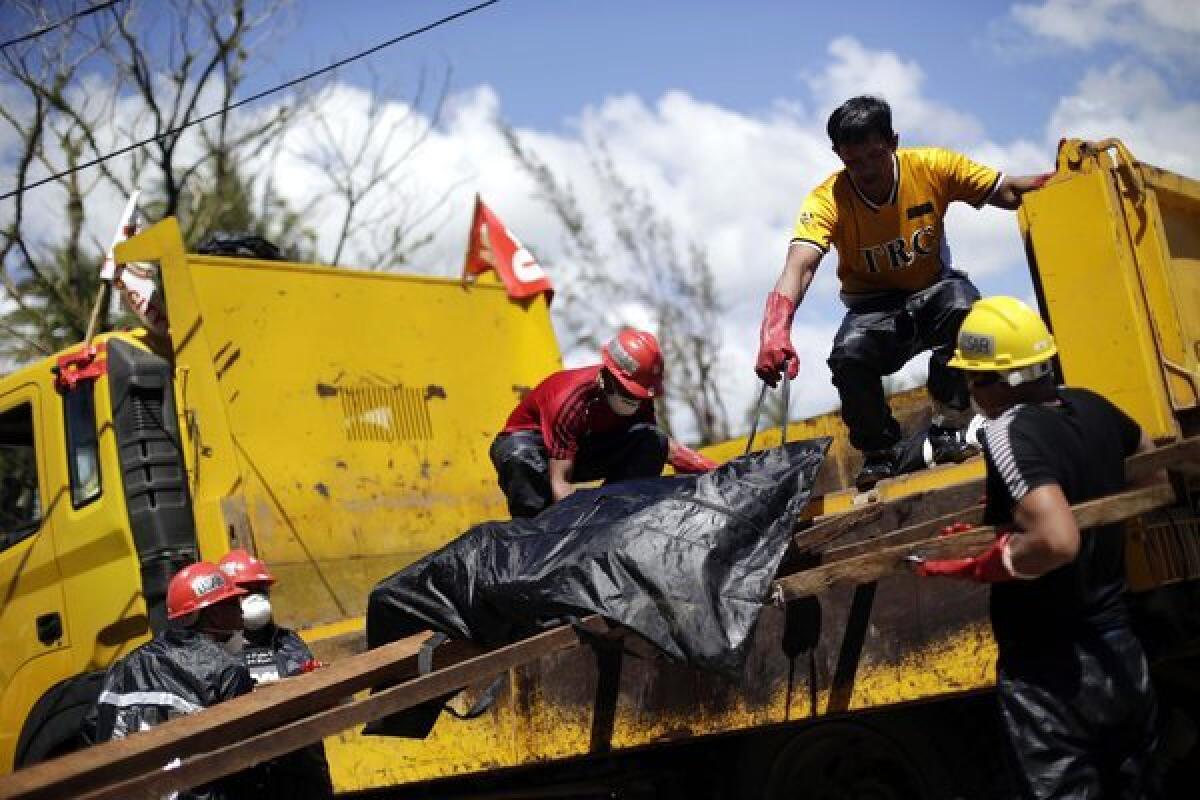In Philippines, Typhoon Haiyan victims buried in communal grave

- Share via
TACLOBAN, Philippines -- In a hilltop cemetery, a truck stacked high with body bags backed up to a yawning trench. With no time for ceremony, police and firefighters wearing facemasks and plastic gloves unloaded the bags Saturday and placed them in a communal grave.
A week after one of the strongest typhoons on record swept through the central Philippines, bodies still lie in the streets of Tacloban, the hardest-hit city. Other corpses remain buried under towering piles of rubble.
Residents pick their way across fields of debris, jostling for aid at a growing number of distribution centers, or busy themselves with makeshift home repairs, wearing masks to block out the putrid smell that hangs over the city. Others wrap scarves around their faces or cover their noses with their shirts.
It has taken several days to assemble the personnel and equipment needed to bury the dead here. Local government structures were decimated by the typhoon known internationally as Haiyan and in the Philippines as Yolanda. Government employees were themselves victims of the storm; some remain unaccounted for.
Interior Secretary Max Roxas told reporters during a recent visit to Tacloban that there were just eight functioning trucks for the city of 220,000. Two of them are being used to collect cadavers, which have decayed rapidly in the stifling heat, said Dr. Bubi Arce, who is overseeing the effort.
Protective clothing and sufficient body bags had to be assembled with the help of national agencies including the Department of Health, armed forces and Philippine Red Cross.
“We were literally picking up bodies with our bare hands,” Arce said.
As of Saturday, the official death toll stood at 3,633 across the country with another 1,179 still missing. But the figures have been a subject of controversy.
A provincial police official who last weekend said that the final figure would likely climb to around 10,000 was removed from his post Thursday. International aid officials have endorsed the estimate, though President Benigno Aquino III and other Philippine officials say it is exaggerated.
One reason for the uncertainty is that many hard-hit villages remain out of reach because of debris-clogged roads, leaving victims unburied and uncounted.
Most of the deaths occurred on the islands of Leyte and Sama. Tacloban, the Leyte provincial capital, was especially hard-hit because of massive storm surges. Many victims were swept away in the churning waters or drowned in their homes.
By the end of the day Friday, 575 bodies had been retrieved in Tacloban and ferried up the hill for burial, Arce said.
Basic information about the victims has been recorded, including gender, location where their bodies were found and what they were wearing. Bodies are searched for identifying information, photographs and fingerprints are taken, and area residents are questioned about what they know so that families can be informed, said Senior Supt. Emmanuel Aranas, deputy director of a police crime lab.
But with each passing day, Aranas added, identifying features are deteriorating and there isn’t time or resources for more sophisticated forensic work. The priority is to bury bodies to avoid the spread of disease.
Many families may never know what happened to their loved ones.
“The families usually accept the situation,” Aranas said. “There are so many tragedies here.”
By the end of the day Saturday, body bags lined most of a more than 100-yard-long trench. Organizers wanted to dig another one, but the backhoe had stopped working.
Police and firefighters, some of them wearing gas masks, said little as they labored, until a tiny black bag was lifted from the truck.
“Baby, baby,” the call went out.
The smell was overpowering. A firefighter leaned over and retched.
“Hard time,” commented a police officer, barely able to complete a sentence as he stepped to one side to catch his breath. “So many.”
And still, the bodies keep coming.
ALSO:
Philippines government defends typhoon response
China to loosen its one-child policy, end labor camps
Remittances to Latin America rebound -- except in Mexico[email protected]
Times staff writer Barbara Demick in Beijing contributed to this report.
More to Read
Sign up for Essential California
The most important California stories and recommendations in your inbox every morning.
You may occasionally receive promotional content from the Los Angeles Times.










